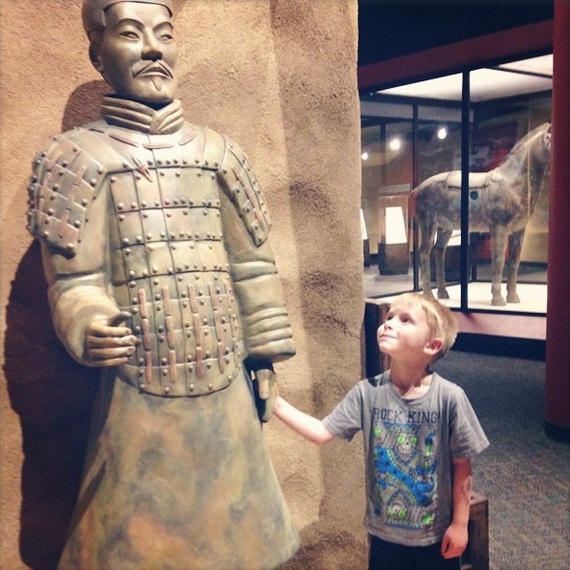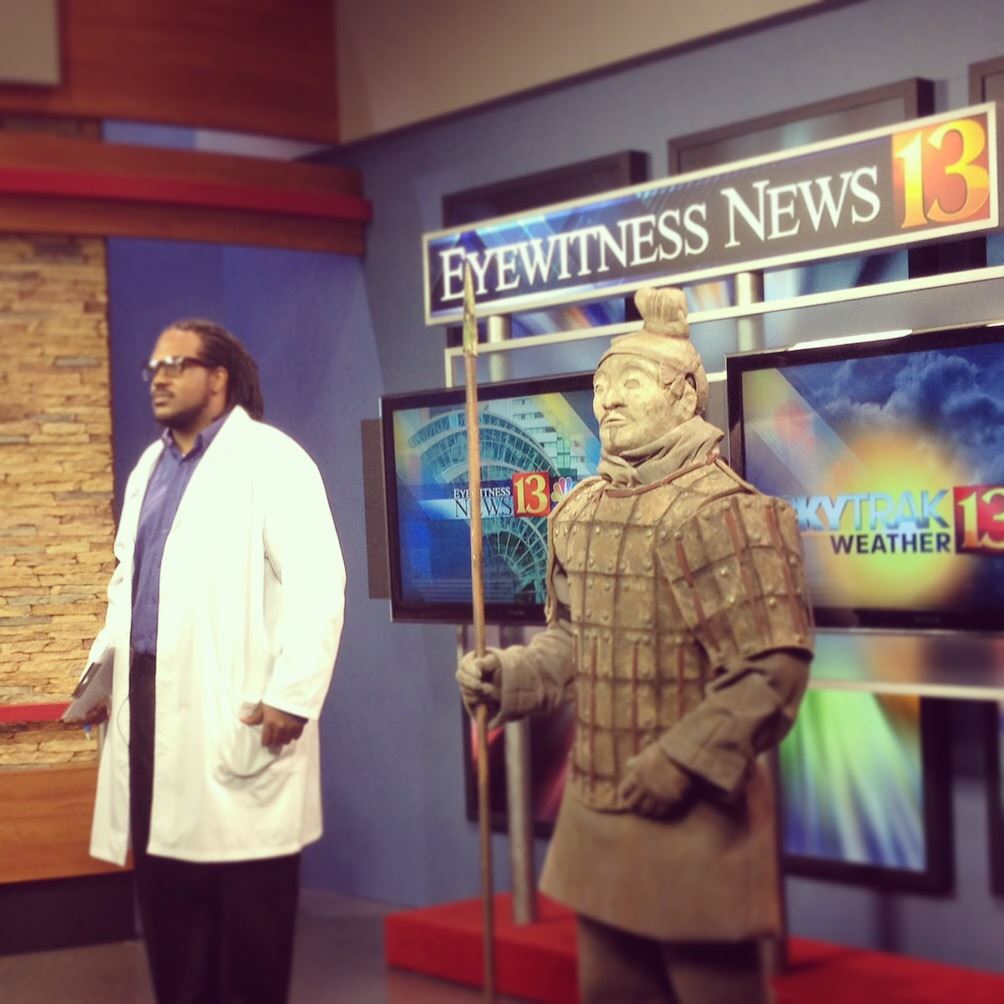Museum Theatre:
small, Medium, or SUPERSIZE?
By Todd D. Norris
Associate Vice President of Interpretation and Family Programs,
Children's Museum of Indianapolis
During each new training class for incoming interpreters, Josh Estes, STEM & SPX Galleries Interpretation Manager, likes to tell our new hires that every day, we are hosting an amazing party for our guests. He is right. During our guests’ stay with us, we will use every trick in our arsenal to educate, amuse, delight, stimulate, reveal, spark, grow, and engage them, regardless of age. We are called a Children’s Museum, but we are actually a Families’ Museum. Our exhibits and programs are designed purposefully to engage the entire age spectrum, from toddlers to seniors. We also recognize that there are more and more choices for families to spend their recreational and educational dollars on, so the responsibility is on us to provide experiences that they won’t find anywhere else. Experiences that they want to see over and over again. Experiences that turn them on to ideas they hadn’t considered before – and all of it presented in the highest quality, most engaging formats possible. That’s why we give so much attention to the technical aspects of our museum theatre.
The Interpretation department at TCM is fortunate to have great institutional support at the highest level, and we are fortunate that we are usually provided resources to execute our assignments. But we also realize that bigger is not always better, and that the right tool for the job is crucial to success. We create museum theatre at several levels, depending on different factors including content, performance area, family learning goals, and run time of the exhibit. The technical requirements vary, but we take all of these factors into consideration to make sure that the small programs are supported in a way that allows us to deploy other resources for larger scale productions. Some of our shows are designed to attract guests to the museum or to a specific exhibit, some are designed to elaborate on themes presented in the galleries, and some are designed to explore related content that floor space or label limits restrict.
Like most institutions, many of our programs are built on formulas that have been time-tested for success. Occasionally, we have the opportunity to look for new solutions to technical challenges. What I hope to do is share some recent programs of varying technical sophistication, which I hope will serve as a springboard of ideas for both seasoned and brand new practitioners of Museum Theatre.
.png)
One of the most moving sets of programs we have offered is My Story, the three character monologues that were presented in our National Geographic Sacred Journeys exhibit which opened in 2015. We developed three composite characters, and each one shared their particular story about a pilgrimage that had life changing impacts. One of the simplest formats, a character monologue, did not require heavy technical requirements, but we wanted these simple, powerful stories to shine, so the appropriate tech elements for these were as follows:
- Track lights focused directly onto the playing area
- Costumes that were appropriate, but not eye-catching
- Small images on easels for reference
- One large backdrop for each piece, in this case a vinyl curtain hung on a rod that could be pulled out for shows or tucked behind a wall when not needed.
Of these four elements, the standout “wow” was the backdrops. We chose vivid, dramatic representations of the Western Wall, the Labyrinth of Chartes Cathedral, and bright red Torii Gates. They grounded the pieces visually, and gave the actors a large visual to refer to, but as important and successful as they were, I believe that the lighting – just a couple of adjustable track lights—were more crucial to the actors’ success. It can be surprising how often non-theatrical organizations will present pieces in shadow. Good directors and designers know that if an audience can’t see you, they can’t hear you. If they can’t see the performer’s eyes, they are less likely to connect with the character and the story. In addition, the space usually needs more light than initially we might think. There is a reason spotlights are effective. They focus the eye where the action is. Sometimes, just a small bump in area lighting is enough, particularly in a space not designed for performance, to guide our eyes to the performer, which makes their jobs just a little bit easier. In this image, notice how sharply the sides and top of the space recede into darkness of this multi-purpose room. This particular actor is extremely tall, so we were pushing the boundaries of keeping his face lit, but he and the other five actors who performed these monologues were seen clearly, so they could deliver their compelling stories to receptive audiences of all ages.
 Our large-scale programs take place in our large, open Sunburst Atrium. This atrium connects our welcome center, food court, museum store, and Dinosphere exhibit, and is the central hub of the museum. In the last six years, it has also gradually evolved into a performance venue for audiences of 10–500. One selling point of the museum to members is that we are always changing and developing new experiences. That means that we are also expected to develop new Atrium Shows, which requires increasing ingenuity and resourcefulness from my team, as we have forced this space to mature in its technical capacities far beyond those for which it was designed.
Our large-scale programs take place in our large, open Sunburst Atrium. This atrium connects our welcome center, food court, museum store, and Dinosphere exhibit, and is the central hub of the museum. In the last six years, it has also gradually evolved into a performance venue for audiences of 10–500. One selling point of the museum to members is that we are always changing and developing new experiences. That means that we are also expected to develop new Atrium Shows, which requires increasing ingenuity and resourcefulness from my team, as we have forced this space to mature in its technical capacities far beyond those for which it was designed.
In many ways, our newest Atrium Show, Sports Legends Spectacular! is one of the smallest of these programs. The goal of this short, seven-minute pep rally is to get our guests pumped up to go outdoors and explore our new 7.5 acre, three-gallery expansion, Riley Children’s Health Sports Legends Experience. This is our shortest Atrium Show, and uses one actor as a cheerleader. We use two staff as “backstage techs,” to run the music, and to coach the families, as there are seven audience participation moments written into the script. The technical elements for this production are:
- Intelligent lights programmed to provide a ballyhoo effect
- Recorded voice and music throughout the piece
- Lighting to brighten the stage area
- Split background banner for the audience “rookies” to burst through
- Fog machine
- Oversized prop trading cards and jerseys for audience recruits
- Clipboard for recording “rookie” names for announcements
- Cheerleader costume, pompoms, and cheer flag
One of the aspects we consider when selecting equipment for a show is whether we will be able to reuse that same equipment for other programs, which saves money in the long run. A few years ago, we created a fairytale Atrium Show, and because of large hats, wigs, and set placement, the actors’ faces were always in the shadows. My team was able to work to hang two lights that had the effect of warming the actors’ faces just a bit, so they could be better seen. The Sunburst Atrium is a large, open space, and when the sun is bright, it isn’t always a noticeable difference, but on overcast days, it makes a world of difference. A bit of an investment for a subtle, but crucial result. Those lights are now a part of all the Atrium Shows, as they bump up the quality in a subtle, but meaningful way. We
have used fog machines in several of our Atrium Shows, in our DIY Circus gallery program, and our theatre, so our investment in those units has paid off many times over. The intelligent lights were the major new addition for this show, but after this show finishes its run, if we don’t need them for the next one, they will be moved to the theatre, where we use intelligent lights in almost every production.

When the Children's Museum of Indianapolis featured the Terra Cotta Warriors in 2014, we were tasked to create an experience that would encourage attendance and also spark the curiosity of our young guests to want to learn more about these ancient wonders. We had great success with bringing the fossils of our juvenile T. rex, Bucky, to life, so we sought to do the same with one of the warriors. We knew that we needed a higher-quality costume than we could produce in house, or that was available commercially, so we partnered with the costume design faculty and students at Butler University. The class worked from their professor’s design to build and paint an amazing costume that continues to surprise and delight audiences each time we present this magical program. In the picture at left, a child looks at a replica of a Terra Cotta Warrior.
In the picture below, you see our archaeologist, “Dr. Schloss,” with our version of the standing warrior at a local television station. Butler did a pretty good job, don’t you think?

This show is the most content-heavy of all our large shows, so to get across all the points, the following tech elements were used:
- Vinyl backdrop
- Customized “crate” with hand truck containing colored lighting
- Replica weapons: sword, crossbow, spear
- Large photo close-up of statue with paint
- Lab coat costumes for actor and child assistants
- Camera with flashbulb
- Clipboard and pencil
- “Jade tablet” prop with embedded LED lighting
- “Jade tablet fragment” for audience plant
- Recorded music
We were fortunate to be able to take advantage of some staff creativity for this project, as our Interpretation Operations Manager, Johnny Marquis, had excellent ideas about building the tablet, embedding lights in it, and constructing the crate and adding the lighting. He was able to fabricate the tablet out of foam and LED lights, and was able to work with our in-house production team to build the crate. This show provides six opportunities for audience participation, covers at least five content-points, and still provides surprises, laughter, and WOW moments to audiences. One of the best parts of this project has been that even though the Warriors have long since marched on, this content still connects directly to the subject matter in our archaeology gallery, so we continue to be able to offer this show for years to come.
The simplest programs require an actor, and audience, and a place to present. Assuming the actor can be seen and heard sufficiently, that is all that is needed. Many museums, including the Children's Museum of Indianapolis, present simple, effective programs using little more than these essentials. But, as exhibitions, audiences, and expectations evolve, those of us who create museum theatre have an obligation to meet and exceed those expectations. This is not to say that large budgets and resources are requirements for compelling theatre, but rather a reminder that the consideration of the most basic technical elements, sound and light, can enhance a good presentation, which can ignite a spark of curiosity in the audience, and from there, we can build on our successes to bring our audiences along with us to new levels of experience, and greater heights of exploration. 
This article can be found in Spring 2018 - "The Future is Now: Tech in Museum Theatre" (Volume 28, Issue 2) of IMTAL Insights.

ABOUT THE AUTHOR:

Todd D. Norris is the Associate Vice President of Interpretation and Family Programs for the Children’s Museum of Indianapolis. Prior to moving to Indiana in 2013, Todd held several positions at The Colonial Williamsburg Foundation including Training Specialist, Manager of Evening Programs and Performing Arts, and Senior Manager of Performance Interpretation. In addition to his administrative duties at both institutions, he has written, directed, produced and performed many programs and plays for them. Todd has an MFA in Acting from the University of Louisville and a BA in Theatre Performance from The University of Findlay. He has taught and directed at several schools including The College of William and Mary, Christopher Newport University, Alice Lloyd College and Wright State University. He is an associate member of the theatrical union, Stage Directors and Choreographers Society, and continues to work as a freelance director. He is also an avid amateur musician, having performed at the Sydney Opera House in Sydney, Australia and with the MasterWorks Chorale of the Louisville Orchestra. Todd is currently the Vice President of IMTAL.